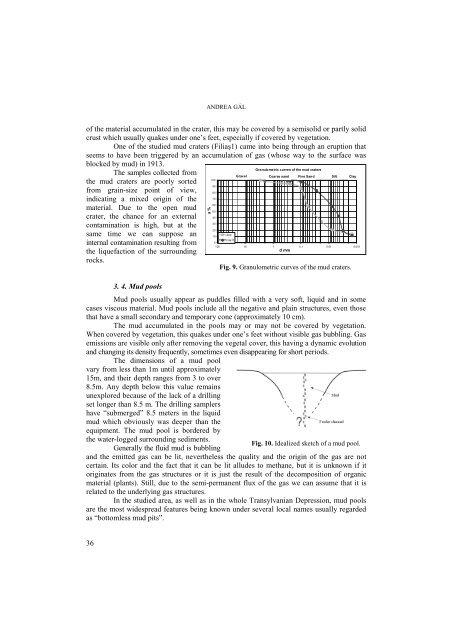geographia - Studia
geographia - Studia
geographia - Studia
Create successful ePaper yourself
Turn your PDF publications into a flip-book with our unique Google optimized e-Paper software.
ANDREA GÁL<br />
of the material accumulated in the crater, this may be covered by a semisolid or partly solid<br />
crust which usually quakes under one’s feet, especially if covered by vegetation.<br />
One of the studied mud craters (Filiaş1) came into being through an eruption that<br />
seems to have been triggered by an accumulation of gas (whose way to the surface was<br />
blocked by mud) in 1913.<br />
The samples collected from<br />
the mud craters are poorly sorted<br />
from grain-size point of view,<br />
indicating a mixed origin of the<br />
material. Due to the open mud<br />
crater, the chance for an external<br />
contamination is high, but at the<br />
same time we can suppose an<br />
internal contamination resulting from<br />
the liquefaction of the surrounding<br />
rocks.<br />
3. 4. Mud pools<br />
Mud pools usually appear as puddles filled with a very soft, liquid and in some<br />
cases viscous material. Mud pools include all the negative and plain structures, even those<br />
that have a small secondary and temporary cone (approximately 10 cm).<br />
The mud accumulated in the pools may or may not be covered by vegetation.<br />
When covered by vegetation, this quakes under one’s feet without visible gas bubbling. Gas<br />
emissions are visible only after removing the vegetal cover, this having a dynamic evolution<br />
and changing its density frequently, sometimes even disappearing for short periods.<br />
The dimensions of a mud pool<br />
vary from less than 1m until approximately<br />
15m, and their depth ranges from 3 to over<br />
8.5m. Any depth below this value remains<br />
unexplored because of the lack of a drilling<br />
set longer than 8.5 m. The drilling samplers<br />
have “submerged” 8.5 meters in the liquid<br />
mud which obviously was deeper than the<br />
equipment. The mud pool is bordered by<br />
the water-logged surrounding sediments.<br />
Generally the fluid mud is bubbling<br />
a %<br />
100<br />
90<br />
80<br />
70<br />
60<br />
50<br />
40<br />
30<br />
20<br />
10<br />
0<br />
100<br />
and the emitted gas can be lit, nevertheless the quality and the origin of the gas are not<br />
certain. Its color and the fact that it can be lit alludes to methane, but it is unknown if it<br />
originates from the gas structures or it is just the result of the decomposition of organic<br />
material (plants). Still, due to the semi-permanent flux of the gas we can assume that it is<br />
related to the underlying gas structures.<br />
In the studied area, as well as in the whole Transylvanian Depression, mud pools<br />
are the most widespread features being known under several local names usually regarded<br />
as “bottomless mud pits”.<br />
Atid<br />
Filia?1<br />
10<br />
Granulometric curves of the mud craters<br />
Gravel Coarse sand Fine Sand Silt Clay<br />
1<br />
d mm<br />
Fig. 9. Granulometric curves of the mud craters.<br />
0.1<br />
0.01<br />
0.001<br />
Fig. 10. Idealized sketch of a mud pool.<br />
36

















